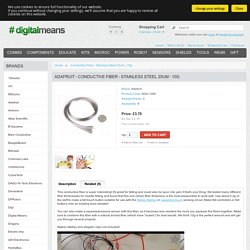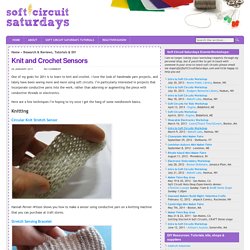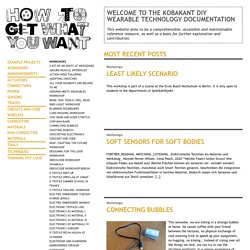

Soft Electronics. Conductive Fiber - Stainless Steel 20um - 10g. This conductive fiber is super interesting!

It's great for felting and could also be spun into yarn if that's your thing. We tested many different fiber thicknesses for needle felting and found that this one (20um fiber thickness) is the most pleasurable to work with. Use about 0.2g of the stuff to make a felt touch button suitable for use with the MaKey MaKey or capacitive touch sensing circuit. Make felt controllers or felt buttons onto an existing wool sweater! You can also make a squeeze/pressure sensor with this fiber, as it becomes less resistive the more you squeeze the fibers together.
MaKey MaKey and alligator clips not included! Free And Dirty Conductive Thread. Know It All bag: Knitty Spring+Summer 2010. Seaming: Note: Recommended sewing technique for this bag is whip stitch, worked with right sides together (wrong sides facing out), sewn loosely, working a half-stitch in from edge instead of full stitch in from the edge to keep the seam from getting too bulky.

Working seams in this way will allow seams to felt at the same rate as the rest of the bag. Using MC, sew each end of strap/gusset to side edges of bag body, between markers; take care not to twist strap when sewing second end. Sew side edges of shorter side of bag body (side without CC stripe) along edges of gussets. Sew side edges of longer side of bag body to remaining edges of gussets, leaving top portion of bag body free to form flap. Weave in ends. Felting: Felt bag to given dimensions.
Needle-felted grid: Needle felting uses a barbed needle to force wool strands to interlock and felt. IMPORTANT: Read all Pattern Notes before proceeding! Back Stitch: Running Stitch: Isolate the positive circuits: Do this all in one sitting. Softcircuitsaturdays.com » Blog Archive » Knit and Crochet Sensors. Home » Research & Reviews, Tutorials & DIY Knit and Crochet Sensors 29 January 2011No Comment One of my goals for 2011 is to learn to knit and crochet.

I love the look of handmade yarn projects, and lately have been seeing more and more using soft circuits. I’m particularly interested in projects that incorporate conductive yarns into the work, rather than adorning or augmenting the piece with conductive threads or electronics. Here are a few techniques I’m hoping to try once I get the hang of some needlework basics. Knitting Circular Knit Stretch Sensor Hannah Perner-Wilson shows you how to make a sensor using conductive yarn on a knitting machine that you can purchase at craft stores. Stretch Sensing Bracelet Another technique from Hannah uses conductive and resistive yarns to make a bracelet that only lights up when you stretch it. Crochet Felted Crochet Stretch Sensor Crochet Tilt Potentiometer Crochet Pressure Sensor Ready Made Plug and Wear Sensitive Fabrics.
Lara-grant. HandcraftingSensors. HOW TO GET WHAT YOU WANT - techniques. Relief Embrodiery Relief embroidery on leather is traditionally used in Austria to create decorative patterns on the surface of the leather used in Lederhosen.

The embroidery thread does not pass through the material, instead it is stitched back and forth, pulling together the leather and creating a “bump” (germ. “wulst”). This bump also serves a purpose of […] Ikat Woven Conductive Thread Ikat is a technique of partially dying yarns before weaving them to create a patterned fabric. Batik Etching Conductive Fabrics Using Batik was as a resist, applying it to copper fabric and etching in a salt and vinegar bath. Dyeing Conductive Yarn Conductive yarns are often in gray color which makes your project looks grayish. Weaving Conductive Fabric Commercially available conductive fabrics are mostly evenly coated basic woven and knit structures. Fabric Pleating.
Circuiti tessili. AIR Interview: Anne-Marie Lavigne. This week we’re talking to another Cycle 6 Artist in Residence, Anne-Marie Lavigne!

She recently graduated from the Interactive Telecommunications Program at New York University’s TISCH Program of the Arts and was able to give us some insights to her inspiration, design process, and current projects. Your work explores digital fabrication, circuitry and textiles. Could you elaborate on how you became interested in combining these? Textiles have always been used to share information, numbers, laws, stories, etc. Their cultural importance triggered the development of an infinite array of techniques and technology. While in grad school, I started to incorporate fibers into my interactive concepts. For a specific project, I started to incorporate circuitry into the textile structure aiming for a seamless relationship between the textile and electronic component. You come from Quebec which has a rich history in craft. Apart from these influences, where else do you draw inspiration?
E-TEXTILE. How-To videos for eTextiles, soft circuits and wearable computing. ETextiles: How to Select Conductive Thread. eTextile Lounge — everything electronic and textiles. HOW TO GET WHAT YOU WANT. Welcome to the KOBAKANT DIY Wearable Technology Documentation Workshops least likely scenario This workshop is part of a course at the Ernst Busch Hochschule in Berlin.

It is only open to students in the departments of Spiel&&Objekt. Workshops soft sensors for soft bodies FURTHER_READING_WATCHING_LISTENING_ Elektronische Textilien als Material und Werkzeug_ Hannah Perner-Wilson, Irene Posch, 2020 “Welche Fasern leiten Strom? Workshops connecting bubbles This semester, we are sitting in a strange bubble at home. Sensors 6 really wearable sensors The textile sensors on our website are often not designed to be manipulated with your hands. Workshops soft interactive technologies This workshop is a part of a course at the Art Academy Weissensee Berlin.